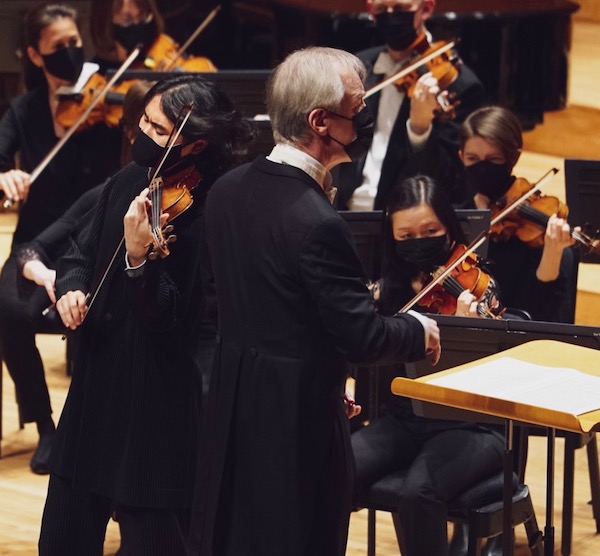Robertson’s return bolsters close rapport with Utah Symphony musicians

After a well-received concert with the orchestra last year, conductor David Robertson returned to Abravanel Hall Friday as the Utah Symphony’s fifth guest conductor in this season of unofficial auditions to succeed Utah Symphony music director Thierry Fischer when his contract expires in 2023. With a program featuring Stravinsky, Mendelssohn, and Brahms, the Southern California native greatly improved his chances and may have cemented his position as the frontrunner.
In contrast to the near-capacity crowd at last weekend’s performances of Handel’s Messiah, Abravanel Hall appeared to be less than half full. However, the small audience responded enthusiastically, particularly to Korean violinist Inmo Yang, who made his Utah Symphony debut with Mendelssohn’s Violin Concerto.
From his first entrance, Yang played with authoritative passion. Sporting long, curly hair and wearing a long coat that swallowed his slight frame, Yang looked younger than his 26 years. Yang’s musicality, charisma and technical prowess made it easy to imagine him having a stellar career.
He infused the infectious melody of the first movement with an energy that was both intensely personal and drew the audience in with widely varied tones and dynamic levels. The technical wizardry of the cadenza flowed naturally and sounded improvisatory in Yang;s hands. He played the sweetly singing lullaby of the second movement with sensitivity, aided by Robertson’s precise rhythms, terraced dynamics, and swelling strings that rose to meet the soloist after every tutti.
The violinist’s communicative phrasing in the plaintive introduction to the third movement grabbed the audience’s attention, and he held it through the dazzling, graceful main theme, which was made more lovely by Robertson’s handling of the countermelody in the low strings.
Yang’s encore was equally individual, offering Ernst Schliephake’s virtuosic arrangement of Rachmaninoff’s Piano Prelude in G minor, which showcased the violinist’s technical prowess.
Like the evening’s soloist, Robertson showed his own wide range, opening the concert with Stravinsky’s Song of the Nightingale, and closing with Brahms’ Symphony No. 3. Robertson’s direction was precise, passionate, and communicative in both works, Robertson held the orchestra in his thrall, allowing him to elicit a wide and diverse palette of colors and tones.
This was particularly evident in the Stravinsky. The material comes from Le rossignol, an opera Stravinsky completed in Paris around the same time as his famous, riot-inducing ballet The Rite of Spring.
While Song of the Nightingale is by turns cacophonous, enchanting and sardonic, parts of it were written years before the composer discovered his polytonal language, with some passages that sound like a late Romantic tone poem. Additionally, much of it is written in a pentatonic scale, which Stravinsky intended to evoke the Chinese origins of the story, which gives it a language all its own.
Robertson combined these disparate elements and influences into a lucid musical narrative, deftly capturing each mood and style without sacrificing the piece’s unity. He made coherent, accessible music out of the polytonal opening passage, which the audience followed so closely that they laughed audibly when it landed on a sardonic trombone slide. Perhaps the most affecting part of the piece was during the mournful march section, where lush, warm chords in the orchestra undergirded a poignant trumpet solo, soulfully played by principal Travis Peterson. Other standout passages by individual musicians included concertmaster Madeleine Adkins’ expressive violin passages and a brilliantly phrased and engaging flute cadenza by Mercedes Smith.
At the time Brahms wrote his Symphony No. 3, his music was considered staid and cerebral in some quarters—especially those inhabited by acolytes of Richard Wagner.
With his passionate interpretation of Brahms’ Third Symphony, Robertson found the fire in the piece, and he and the orchestra poured their energy into its dynamic arc, slowly building to each powerful climax.
Robertson’s ability to precisely sculpt and phrase a passages was most impressive, as were the deep, rich outpourings he achieved in the strings. In the first movement, he gave a captivating, almost danceable lilt to the triple-meter passages, while the second movement landed like a hymn.
Robertson plumbed the depths of the third movement’s mournful theme, building it slowly in the strings and creating a contemplative mood for the sublime horn passages. The aggressive energy of the fourth movement created a stark contrast, and Robertson gave it an intense energy and Beethovenian rhythmic drive.
By the end of the performance, Robertson’s head was covered with sweat as he acknowledged the audience ovations. After he had highlighted the various sections, the orchestra gave him a well-earned foot applause.
The program will be repeated 7:30 p.m. Saturday at Abravanel Hall. www.usuo.org.